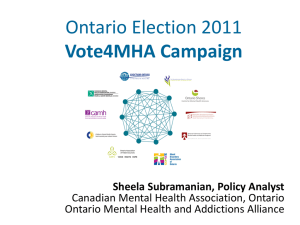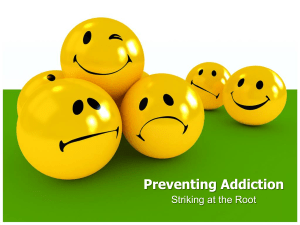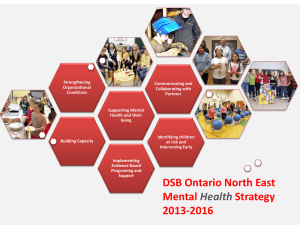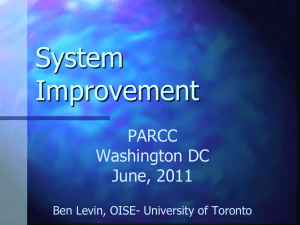Inter-Ministerial Generic deck (MCYS MOHLTC EDU and TCU
advertisement
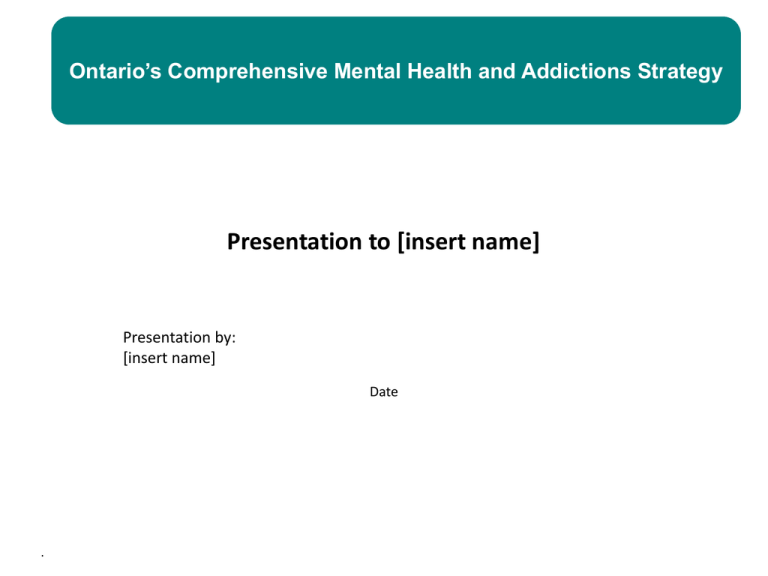
Ontario’s Comprehensive Mental Health and Addictions Strategy Presentation to [insert name] Presentation by: [insert name] Date . Ontario’s Comprehensive Mental Health and Addictions Strategy Purpose of this presentation: • To provide an overview of results to date of the Comprehensive Mental Health and Addictions Strategy (Strategy); and • To engage in discussions regarding opportunities for ongoing collaboration with Local Health Integration Networks in implementing the Strategy. 2 Ontario’s Comprehensive Mental Health and Addictions Strategy Context • In 2006, MCYS released A Shared Responsibility, Ontario’s Policy Framework for Child and Youth Mental Health (Policy Framework). Its four goals are: 1. A child and youth mental health sector that is coordinated, collaborative and integrated at all community and government levels, creating a culture of shared responsibility; 2. Children, youth and their families/caregivers have access to a flexible continuum of timely and appropriate services and supports within their own cultural, environmental and community context; 3. Optimal mental health and well-being of children and youth is promoted through an enhanced understanding of, and ability to respond to, child and youth mental health needs through the provision of effective services and supports; and 4. A child and youth mental health sector that is accountable and wellmanaged. • • Following release of the Policy Framework, MCYS and funded child and youth mental health (CYMH) services completed a ‘mapping’ exercise that took a “point in time” snapshot of CYMH services in Ontario for the 2007-08 fiscal year. Mapping showed that there was more to do to build a system in which services are more responsive, integrated, accountable and focused on what Ontarians need when they need it. 3 Ontario’s Comprehensive Mental Health and Addictions Strategy Context “One of the criticisms of Ontario’s overall mental health and addictions system is that there is, in fact, no coherent system….Many people simply fall through the cracks, or give up in frustration because of the complexity of the system.” (Select Committee on Mental Health and Addictions, 2010) 4 Ontario’s Comprehensive Mental Health and Addictions Strategy • The 2011 Ontario budget announced funding, that by 2013-14 will grow to $93 million to support a comprehensive Mental Health and Addictions Strategy, creating a more responsive and integrated system, starting with children and youth. Moving “…the system forward rapidly…while laying the foundation for broader system changes. Such comprehensive reform of the child and youth mental health services system is needed to build an effective, efficient and accountable system of services.” (Open Minds, Healthy Minds, 2011) 5 Ontario’s Comprehensive Mental Health and Addictions Strategy Priorities Fast Access to High Quality Services Early Identification and Support Help for Vulnerable Children and Youth with Unique Needs • Build capacity in the community-based sector • Reduce wait times • Meet community needs • Link education, child and youth mental health, youth justice, health care, and the community • Provide tools and support to those in contact with children and youth so they can identify mental health issues sooner • Provide resources for effective responses to mental health issues • Build mental health literacy and local leadership • Increase availability of culturally appropriate services and serve more children and youth • in Aboriginal, remote and underserved communities • With complex mental health needs • At the key transition point from secondary to postsecondary education Support System Change • Support development of an effective and accountable service system for all Ontarians • Build on efforts that promote evidence-informed practice, collaboration, and efficiencies • Develop standards and tools to better measure outcomes for children and youth 6 A Shared Responsibility Across Sectors • • • • Mental health for children and youth is a shared responsibility in Ontario. The first three years of the Strategy are being led by the Ministry of Children and Youth Services, in collaboration with the Ministry of Education and the Ministry of Health and Long-Term Care. The Ministry of Training, Colleges and Universities is also involved with youth transitioning to postsecondary education. One sector cannot, and should not do it alone. Collaboration is needed at all levels - provincial, regional, and individual communities. In order to change the system, we need to work together and be willing to change in order to best serve children and youth. 7 Results to Date There are over 770 new mental health workers across the province including: • 260 new workers in community child and youth mental health agencies to provide kids access to services closer to home; • 144 nurses working with district school boards and local schools to support the early identification and treatment of students with potential mental health and/or addiction issues; • 72 Mental Health Leaders in school boards to provide leadership and coordination in effective school mental health; • 21 new workers in the court system to keep youth out of the justice system and refer them instead to community-based services; • 19 new full-time Nurse Practitioner positions for pediatric and adult eating disorders treatment services; • 175 additional new mental health workers in schools, who will provide kids support to address their mental health needs; and • More than 80 new Aboriginal mental health and addictions workers in high needs communities. 8 Results to Date (continued) Building collaborative capacity on the front lines through: • Working Together for Kids’ Mental Health in 11 communities (Niagara, Belleville, Sudbury, Haliburton, Simcoe, Peel, Frontenac, Lennox/Addington, Lambton, Ottawa and Hamilton), involving over 300 participating organizations; • A pilot peer-support system navigation program for families in selected communities; • Expanded Telepsychiatry for children and youth through the Ontario Telemedicine Network to increase connectivity to over 1,400 locations; • Evidence-based resources and supports to school board administrators and educators to better understand and effectively support child and youth mental health and addictions; • New and expanded eating disorders treatment services, including inpatient, day treatment and outpatient programs (pediatric and adult); and • Service collaboratives established in 11 communities, bringing together service providers across sectors to deliver a seamless system of mental health and addictions services. 9 Mental Health in Our Schools Vision: • Ontario’s schools are recognized at home and world-wide as strong academic organizations that foster and support student well-being • Schools are an optimal setting to: Reduce stigma Promote positive mental health Build student social-emotional learning skills Prevent mental health problems in high risk groups Identify students in need Build pathways to care Key System Priorities: • Enhanced Coordination Within and Across Sectors • Dedicated Leadership in School Boards • Implementation Support • Increased Mental Health Awareness and Literacy 10 Mental Health in Our Schools (continued) School Mental Health ASSIST – Provincial Implementation Support Team • Three areas of focus in Ontario School Boards: Organizational Conditions Mental Health Awareness, Literacy, Expertise for different groups of school board staff, based on needs Evidence-Based Mental Health Promotion and Prevention Programming in schools Key Activities: • Co-creation of resources with key provincial stakeholder groups for buy-in, support and effective implementation • Leadership support and implementation coaching for Mental Health Leaders, including a Community of Practice (in person and on-line) • Consultation and Knowledge Exchange 11 Mental Health in Postsecondary Institutions Key Strategies • To support youth in colleges and universities with a two-pronged approach that includes: - a province-wide hotline dedicated to postsecondary students - a Mental Health Innovation Fund for postsecondary institutions, student groups and local mental health providers with a postsecondary partner. Postsecondary Mental Health Hotline • $2M annually for Kids Help Phone to serve students for general mental health concerns and issues specific to postsecondary life, such as anxiety related to admissions/withdrawals, academic performance, residence living, alienation and loneliness. • Kids Help Phone is partnering with CONNEX and 211.ca to ensure data is shared and a “warm transfer” of calls will occur and with the Centre of Excellence for Child and Youth Mental Health on an evaluation framework. • Hiring and training of staff has started and a discrete brand is being developed with the help of students and the postsecondary sector. • A ‘soft’ launch is planned for the Spring with full implementation for the start of the school year in September. 12 Mental Health in Postsecondary Institutions (continued) Mental Health Innovation Fund • Up to $7M annually for innovative projects with the potential to improve mental health services and outcomes for Ontario’s postsecondary students. • The Ministry has approved 10 projects for funding to date totalling $6.34 million over three years. Projects range from peer mentoring programs, northern access initiatives, mental health first aid, and holistic wellness. A second call for proposals is about to be released. • The following universities have received funding: Brock, Laurentian, OCAD University and Queen’s (2 projects). As well, these colleges have been funded: Confederation, Humber and Sault. EGALE Canada and Colleges Ontario have also received funds. • Colleges Ontario’s proposal, in partnership with the Council of Universities and CMHA – Ontario, includes the development of a Centre for Innovation for Campus Mental Health with three primary functions: support for a community of practice, a change lab for new innovations, and coordination of community services and expert advisors. 13 Mental Health and Addictions Nurses in Schools • • • • Mental Health and Addictions Nurses in schools work as part of an interdisciplinary school team that includes mental health workers, mental health leaders and other school board staff. Nurses are providing the support of a health professional to help students (and families where appropriate) access primary health care, community mental health and/or addictions services and provide education about options for treatment. Students transitioning back to school from a hospital/institution because of a mental health and/or substance use issue, is a particular focus. Nurses will continue to build collaborative relationships across sectors and with existing services and resources to support students with mental health and/or addictions issues. MOHLTC is developing an evaluation plan to: Ensure the program is being implemented as intended Determine whether the program design is suited for its target population Provide recommendations for program and quality improvement 14 Service Collaboratives • • • • Service collaboratives are groups of service providers from diverse sectors working together to plan and deliver a seamless continuum of mental health and addiction services in a region or community, based on identified need. Led by the Centre for Addiction and Mental Health, the first four service collaboratives have been established and have prioritized their local system gaps: Thunder Bay – enhancing community linkages and MHA supports for Dennis Franklin Cromarty high school students Ottawa – continuity of care for high risk youth in service transitions Simcoe/Muskoka – coordination of care for transition-aged youth (14-24) London – transition from hospital/emergency to community services for youth with MHA The second set of service collaboratives has been initiated in Durham, Hamilton, Frontenac/Kingston, Peel and Waterloo/Wellington and are in the early stages of development. The first two justice collaboratives will be established in the Champlain and Toronto regions, starting in early 2013. 15 Strategy Evaluation Framework and Scorecard • The Institute for Clinical Evaluative Services (ICES) is leading the development of an evaluation framework for the Strategy and a mental health and addictions scorecard, starting with children and youth. Strategy Evaluation Framework • The Strategy evaluation framework provides a plan for assessing the Strategy’s overall impact. Each of the 22 Strategy initiatives are being implemented and monitored or evaluated by the lead ministries. • Logic models have been developed to map the inputs, processes, outputs and expected outcomes of each of the Strategy initiatives, and integrated to develop a picture of the strategy at a system level. • Evaluation questions will be confirmed in Spring 2013 to identify specific areas for study using quantitative and qualitative research methods. Scorecard • A Child and Youth Linkable De-identified (ChYLD) data repository is in development to enable linked data analysis across health, education, children and youth services, social services and justice sectors. • ICES has undertaken an extensive Privacy Impact Assessment to ensure that any development involving data is consistent with privacy and legal requirements. • Indicators for the scorecard will be finalized in spring 2013, and populated with baseline data over the coming months. • Performance measures will be publicly reported as the strategy moves forward. 16 We are committed to system change because… We know, from families, youth, and from reports over the years, that: • The mental health needs of children and youth are not being met similarly across the province; • Families have difficulty finding their way to the right service in a timely way; • Cross-sectoral linkages and pathways are not consistent or robust; and • The sector lacks a coherent approach to standards, performance measures and accountability. 17 Moving on Mental Health – a system that make sense for children and youth Moving on Mental Health is the next step in transformation of the child and youth mental health system. Moving on Mental Health was launched at the Children’s Mental Health Ontario Conference in November 2012. We will transform the experience of children and youth with mental health problems and their families, so that regardless of where they live in Ontario they will know: What mental health services are available in their communities; and How to access mental health services and supports that meet their needs. 18 We will accomplish this system change by: Creating and supporting pathways to care – there will be clear and streamlined pathways to care between primary care, schools and the supports that children and youth need Defining core services – we will identify the core community-based CYMH services for which MCYS funded lead agencies will be responsible for ensuring are available to children and youth in their communities Establishing lead agencies in every community – there will be a visible, accountable entity in each community, responsible for ensuring the delivery of core services Developing a transparent, equitable funding model – we will develop a funding model that is fair, transparent and responsive to community needs Putting in place appropriate legislative/regulatory/ accountability tools 19 Looking Ahead to 2015 Transformed Child and Youth Mental Health Services CURRENT STATE Fragmented, inefficient, hard to access, providercentric Services not consistently matched to needs Many providers; uneven access to equitable service Lengthy wait times Duplication and silos Cannot demonstrate results Historical funding distribution FUTURE STATE Child and youth centred, responsive, flexible, seamless, equitable, evidence-informed and matched to needs Acceptable Accessible Efficient Coordinated Collaborative Effective Sustainable What It will look like • Parents, children and youth know how to access services, what is available to them, and what to expect at each point along transparent service pathways. • Regardless of where they live, families have access to a consistent set of easy to identify supports and services through an identifiable lead agency that is accountable to government. • Coordination between providers and across sectors Parents, children and youth have confidence in the people and agencies providing services. • Linked standards contracting, performance and results Wait times for service are timely, predictable, and matched to severity of need. • Parents and funders know whether the services received have made a difference. Valid tools, evidenceinformed practice Defined communities, lead agencies, and core services Pathways/needs and timeliness at centre of service delivery Funding tied to population, needs, and performance 20 Appendix - Overview of the Three Year Plan Starting with Child and Youth Mental Health INDICATORS THEMES Our Vision: An Ontario in which children and youth mental health is recognized as a key determinant of overall health and well-being, and where children and youth reach their full potential. Provide fast access to high quality service Early identification and support Help for vulnerable children and youth with unique needs Children, youth and families will know where to go to get what they need and services will be available to respond in a timely way. Professionals in community-based child and youth mental health agencies and teachers will learn how to identify and respond to the mental health needs of kids. Children and youth will receive the type of specialized service they need and it will be culturally appropriate • Fewer hospital (ER) admissions and readmissions for child and youth mental health • Higher graduation rates • Reduced Wait Times INITIATIVES Improve public access to service information Pilot Family Support Navigator model Funding to increase supply of child and youth mental health professionals Increase Youth Mental Health Court Workers Reduce wait times for service, revise service contracting, standards, and reporting Outcomes, indicators and development of scorecard • Reduced child and youth suicides/suicide attempts • Educational progress (EQAO) • Fewer school suspensions and/or expulsions • Higher parent satisfaction in services received Implement Working Together for Kids’ Mental Health Amend education curriculum to cover mental health promotion and address stigma Implement standardized tools for outcomes and needs assessment Develop K-12 resource guide for educators • • • More professionals trained to identify kids’ mental health needs Decrease in severity of mental health issues through treatment Decrease in inpatient admission rates for child and youth mental health Enhance and expand Telepsychiatry model and services Hire new Aboriginal workers Implement Aboriginal Mental Health Worker Training Program Provide support at key transition points Improve service coordination for high needs kids, youth and families Implement school mental health ASSIST program and mental health literacy provincially Provide designated mental health workers in schools Expand inpatient/outpatient services for child and youth eating disorders Hire Nurse Practitioners for eating disorders program [part of New Nurses Initiative] Implement Mental Health Leaders in selected School Boards Provide nurses in schools to support mental health services [part of New Nurses Initiative] Create 18 service collaboratives Plan Evaluation Ontario’s Comprehensive Mental Health and Addictions Strategy 21
